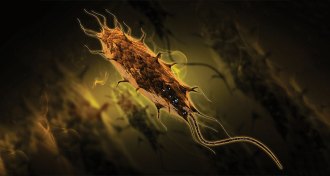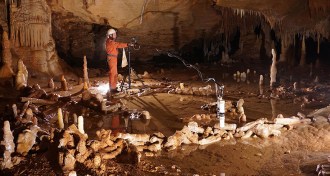Humans
Sign up for our newsletter
We summarize the week's scientific breakthroughs every Thursday.
-
 Archaeology
ArchaeologyEarliest evidence of fire making in Europe found
Clues to Stone Age fire making surface in a Spanish cave.
By Bruce Bower -
 Neuroscience
NeuroscienceMorphine may make pain last longer
Instead of busting pain, morphine lengthened the duration of pain in rats with a nerve injury.
-
 Tech
TechNanoparticles beat back atherosclerosis
Nanoparticles that find and destroy waxy plaques in blood vessels could be the next big treatment for heart disease.
-
 Life
LifeBacteria resistant to last-resort antibiotic appears in U.S.
For the first time in the United States, scientists have reported a patient infected with a strain of bacteria carrying the gene mrc-1, making it resistant to the last-ditch antibiotic colistin.
By Meghan Rosen -
 Climate
ClimateClimate probably stopped Mongols cold in Hungary
Mongol cavalry was no match for cold, wet climate in medieval Hungary, researchers think.
-
 Psychology
Psychology‘Vocal fry’ makes female singers seem expressive
Female singers who use vocal fry, the deep, creaky vocal effect made famous by pop stars like Britney Spears, may sound more expressive to listeners.
By Meghan Rosen -
 Neuroscience
NeuroscienceAlzheimer’s culprit may fight other diseases
A notorious Alzheimer’s villain may help bust microbes.
-
 Archaeology
ArchaeologyStone circles show Neandertals’ social, technical skills
Ancient human relatives built circular stalagmite structures inside a French cave.
By Bruce Bower -
 Life
LifeWomen in sports are often underrepresented in science
More and more women are taking up recreational and competitive sports. But when it comes to exercise science, the studies don’t reflect that trend.
-
 Health & Medicine
Health & MedicineResearchers face off over whether newborns are really copycats
Scientists disagree about whether babies can imitate movements and facial expressions shortly after birth.
By Bruce Bower -
 Archaeology
ArchaeologyEvidence of 5,000-year-old beer recipe found in China
Ancient brewer’s toolkits put barley on tap in China as early as 3400 B.C.
-
 Life
LifeScientists find way to break through bad bacteria’s defenses
Enzymes can break down bacterial biofilm’s sugary walls.